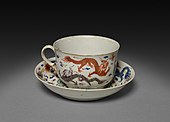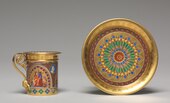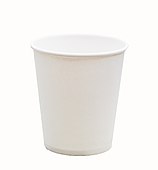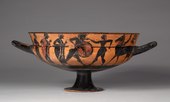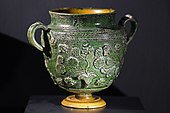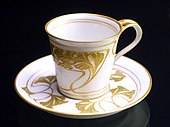Cup

A cup is an open-top container used to hold liquids for pouring or drinking. Although mainly used for drinking, it also can be used to store solids for pouring (e.g., sugar, flour, grains, salt).[1][2] Cups may be made of glass, metal, china,[3] clay, wood, stone, bone, polystyrene, plastic, aluminium or other materials, and are usually fixed with stem, handles, or other adornments. Cups are used for quenching thirst across a wide range of cultures and social classes,[4] and different styles of cups may be used for different liquids or in different situations.[5] Cups of different styles may be used for different types of liquids or other foodstuffs (e.g. teacups and measuring cups), in different situations (e.g. at water stations or in ceremonies and rituals), or for decoration.[5][6]
History
Cups have almost certainly been used since before recorded history, and indeed, they have been found at archaeological sites throughout the world. Prehistoric cups were sometimes fashioned from shells and hollowed out stones.[7]
In ancient Mesopotamia, cups were made for a variety of purposes, possibly including the transportation and drinking of alcoholic beverages.[8]
There is evidence that the Roman Empire used cups throughout Europe, with notable examples including silver cups in Wales and a color-changing glass cup in ancient Thrace.[9][10] In England, cups have been discovered which date back to several thousand years, including the Rillaton Gold Cup, about 3,700 years old. Cups were used in the Americas several centuries prior to the European arrivals.[11] Around the Gulf of Mexico, Native American societies used the Horse conch for drinking cups, among other purposes.[12]
-
Ancient Egyptian lotiform cup; 1295-1185 BC; faience; height: 15 cm, diameter: 9.1 cm; Metropolitan Museum of Art (New York City)
-
Chinese cup and saucer; 1745; porcelain; diameter: 10.2 cm; Cleveland Museum of Art (Cleveland, Ohio, USA)
-
Sèvres cup and saucer, decorated with Gothic Revival ornaments and patterns; 1827; porcelain; overall: 8.2 x 10 cm; Cleveland Museum of Art
-
Typical modern-day, disposable paper cup
Cultural significance and use

Since cups have been an integral part of dining since time immemorial, they have become a valued part of human culture. The shape or image of a cup appears in various places in human cultures.
Monarchy
Historically, monarchs have been concerned about assassination via poisoning. To avoid this fate, they often used dedicated cups, with cup-bearers to guard them. A "divining cup" was supposed to be able to detect poison. In the Bible, Joseph interpreted a dream for Pharaoh's cup-bearer,[13] and a silver divining cup played a key role in his reconciliation with his brothers.
Spa cups are special cups that are used to drink mineral or thermal water directly from a spring, developed in north-west Bohemia during the 17th century[14] and are now part of Czech folklore.
Religion

In the Christian ritual of Communion, adherents drink from a cup of wine (or a wine substitute) to commemorate the Last Supper of Jesus.[15] A chalice is often used for this purpose.
Ancient Greek religious practices included libations. The rhyton was one cup used for libations.
Cuisine
The measuring cup, an adaptation of a simple cup, is a standard tool in cooking that has been in use at least as far back as Roman times. Apart from serving as drinking vessels, cups can be used as an alternative to bowls as a receptacle, especially, for soup. Recipes have been published for cooking various dishes in cups in the microwave.[16]
Heraldry
Chalices are sometimes used in heraldry, especially ecclesiastical heraldry. A Kronkåsa is a type of elaborate wooden cup which was used by the Swedish nobility during the Renaissance.
Child development
Drinking from a cup is a significant step on a baby's path to becoming a toddler; it is recommended that children switch from bottles to cups between six months and one year of age.[17][18] Sippy cups are typically used for this transition.
Sports
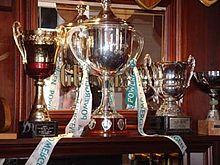
Many trophies take the form of a decorated cup. In cases such as the FIFA World Cup and the Stanley Cup, the competition itself may grow to take on the name of the trophy that is awarded to the winner. Owing to the common usage of cup-shaped trophies as prizes for the winners, a large number of national and international competitions are called "cups".[19]
Games
In Tarot divination, the suit of cups is associated with the element of water and is regarded as symbolizing emotion, intuition, and the soul.[20][21] Cards that feature cups are often associated with love, relationships, fears, and desires.[20][22]
Various cups have been designed so that drinking out of them without spilling is a challenge. These are called puzzle cups.
The cup game involves rhythmically striking plastic cups.[23]
Promotion
In the developed world, cups are often distributed for promotional purposes. For example, a corporation might distribute cups with their logo at a trade show, or a city might hand out cups with slogans promoting recycling. There are companies that provide the service of printing slogans on cups.[24]
Types
Names for different types of cups vary regionally and may overlap. Any transparent cup, regardless of actual composition, is called a "glass"; therefore, while a cup made of paper is a "paper cup", a transparent one for drinking shots is called a "shot glass", instead.
For hot beverages

While in theory, most cups are well suited to hold drinkable liquids, hot drinks like tea are generally served in either insulated cups or porcelain teacups.
Disposable
Disposable cups are intended to be used only once.[25] They are often used by fast-food restaurants and coffee shops to serve beverages. Institutions that provide drinking water, such as offices and hospitals, may also use disposable cups for sanitary reasons.
For alcoholic beverages
Some styles of cups are used primarily for alcoholic beverages such as beer, wine, cocktail, and liquor. There are over a dozen distinct styles of cups for drinking beer, depending on the precise variety of beer. The idea that a certain beer should be served in a cup of a certain shape may have been promulgated more for marketing purposes, but there very well may be some basis in fact behind it.[26] Wine glasses also come in different shapes, depending on the color and style of wine that is intended to be served in them.
- Beer stein
- Pint glass
- Old Fashioned glass
- Quaich[27]
- Sake cup (ochoko)
- Shot glass
- Tankard
- Wine glass
- Goblet
For measurement, suction and breasts
Gallery
-
Minoan Kamares ware; 1800-1700 BC; from Phaistos (Crete); Archaeological Museum of Heraklion (Heraklion, Crete, Greece)
-
Hittite drinking cup in the shape of a fist; 1400-1380 BC; silver; from Central Turkey; Museum of Fine Arts (Boston, USA)
-
Greek kylix; 575-550 BC; black-figure terracotta; diameter: 26.8 cm, overall: 14.1 cm; Cleveland Museum of Art (Cleveland, Ohio, USA)
-
Roman two-handled glazed cup; 1st century BC-4th Century AD; glazed terracotta; Erimtan Archaeology and Arts Museum (Ankara, Turkey)
-
Rectangular wine cup (Zun) with a dragon; 1700s; grayish-white jade; overall: 14 cm; Cleveland Museum of Art
-
Neoclassical coffee cup with saucer; circa 1790; jasper ware with relief decoration; diameter: 13.6 cm; by the Wedgwood Factory (England); Cleveland Museum of Art
-
French cup and saucer, decorated with Renaissance ornaments; 1880–1900; enamel and silver; overall: 6.5 x 8.5 x 6.5 cm; Cleveland Museum of Art
-
Art Nouveau cup; designed by Adolf Flad; 1902; porcelain; Bröhan Museum (Berlin, Germany)
References
- ^ Producer Chris. "Radio 1 Movies Blog: Who Drank From This?". BBC. Archived from the original on September 24, 2015. Retrieved January 26, 2014.
- ^ "Cup - Definition and More from the Free Merriam-Webster Dictionary". Merriam-webster.com. August 31, 2012. Archived from the original on January 8, 2014. Retrieved January 26, 2014.
- ^ "Cup | Define Cup at Dictionary.com". Dictionary.reference.com. Archived from the original on October 7, 2015. Retrieved May 3, 2019.
- ^ Producer Chris. "Radio 1 Movies Blog: Who Drank From This? The Answer". BBC. Archived from the original on September 24, 2015. Retrieved January 26, 2014.
- ^ a b "What Are the Different Types of Coffee Cups? (with pictures)". Wisegeek.com. January 18, 2014. Archived from the original on February 1, 2014. Retrieved January 26, 2014.
- ^ Rigby 2003: p. 573–574.
- ^ Examples include a hollowed stone used to hold pigment for cave painting (see History of technology), and mussel shells used to hold cosmetics. Relics of this style of cup have been found in Egyptian burial sites.
- ^ "The Archaeology News Network: Gold cup headlines Mesopotamia exhibition". Archaeologynewsnetwork.blogspot.com. April 24, 2012. Archived from the original on January 20, 2013. Retrieved January 26, 2014.
- ^ "Roman Cup - Archaeology Magazine Archive". Archaeology. March–April 2004. Archived from the original on February 2, 2014. Retrieved January 28, 2014.
- ^ Merali, Zeeya (September 2013). "This 1,600-Year-Old Goblet Shows that the Romans Were Nanotechnology Pioneers". Smithsonian. Archived from the original on February 1, 2014. Retrieved January 28, 2014.
- ^ Norton, Elizabeth (August 6, 2012). "Starbucks of Ancient America?". ScienceNOW. Archived from the original on February 1, 2014. Retrieved January 28, 2014.
- ^ Atlantic City Aquarium, Horse conch Archived May 15, 2014, at the Wayback Machine. Accessed April 26, 2014
- ^ "Genesis 40 ESV - Joseph Interprets Two Prisoners' Dreams". Bible Gateway. Archived from the original on February 22, 2014. Retrieved January 26, 2014.
- ^ Kuchyňová, Zdeňka (May 2, 2008). "Lázeňský pohárek - typicky česká záležitost" (in Czech). Czech Radio. Archived from the original on January 16, 2017. Retrieved January 15, 2017.
- ^ "Are You Drinking of the Master's Cup?". Cgg.org. Archived from the original on February 1, 2014. Retrieved January 26, 2014.
- ^ "Coffee Cup Quiche". St. Louis Post-Dispatch. May 1, 2012. Archived from the original on January 5, 2015. Retrieved February 9, 2014.
- ^ "Introducing a cup: 8 months and over". Heinz For Baby. Archived from the original on February 19, 2014. Retrieved January 26, 2014.
- ^ Last reviewed: July 2012 (January 1, 2000). "How can I encourage my toddler to drink from a cup?". BabyCentre. Archived from the original on February 2, 2014. Retrieved January 26, 2014.
{{cite web}}: CS1 maint: numeric names: authors list (link) - ^ "'win the cup' Google news search". Google. Archived from the original on May 8, 2014. Retrieved February 3, 2014.
- ^ a b Burger, Evelin; Johannes Fiebig (2004). Tarot Basics. New York: Sterling. p. 76. ISBN 1402730403.
- ^ Tarantino, P.C. (2007). Tarot for the New Aeon. Pebble Beach, CA: Alternative Insights. pp. 245–246. ISBN 978-0976618409.
- ^ Ziegler, Gerd (1988). Tarot: Mirror of the Soul: Handbook for the Aleister Crowley Tarot. York Beach, Maine: S. Weiser. p. 191. ISBN 0877286833.
- ^ "The Cup Game". Great Group Games. Archived from the original on July 30, 2014. Retrieved January 26, 2014.
- ^ "Custom Promotional Cups, Branded Plastic and Paper Cups". Custom On It. Archived from the original on January 22, 2014. Retrieved January 26, 2014.
- ^ Ashby, Michael F. (September 23, 2016). Materials Selection in Mechanical Design. Butterworth-Heinemann. ISBN 9780081006108.
- ^ bilat_22-1.html http://www.truebeer.com/Beer-Glass-Types_ep_22-1.bahog bilat_22-1.html.
{{cite web}}: Check|url=value (help); Missing or empty|title=(help)[permanent dead link] - ^ McClenehan, Robert L. Some Scottish Quaichs. Illinois, 1955, p. 3.
- Rigby, Stephen Henry (2003). A Companion to Britain in the Later Middle Ages (Illustrated ed.). Wiley-Blackwell. ISBN 978-0-631-21785-5.
External links
 Media related to Cups at Wikimedia Commons
Media related to Cups at Wikimedia Commons- Gallery of cups in The Metropolitan Museum of Art


